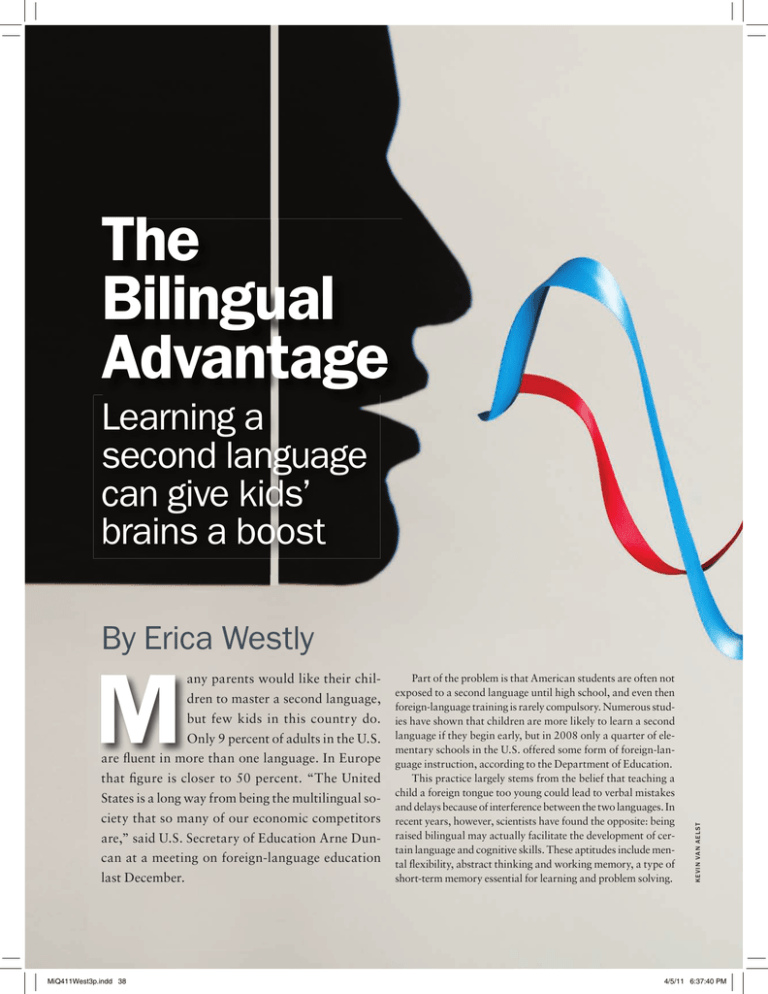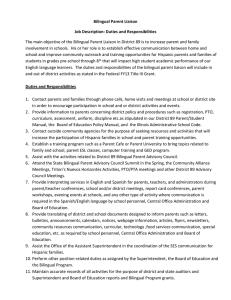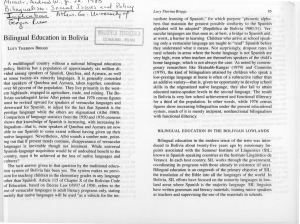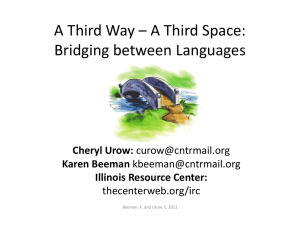The Bilingual Advantage
Anuncio

The Bilingual Advantage Learning a second language can give kids’ brains a boost M any parents would like their children to master a second language, but few kids in this country do. Only 9 percent of adults in the U.S. are fluent in more than one language. In Europe that figure is closer to 50 percent. “The United States is a long way from being the multilingual society that so many of our economic competitors are,” said U.S. Secretary of Education Arne Duncan at a meeting on foreign-language education last December. 38 SCIENTIFIC AMERICAN MIND MiQ411West3p.indd 38 Part of the problem is that American students are often not exposed to a second language until high school, and even then foreign-language training is rarely compulsory. Numerous studies have shown that children are more likely to learn a second language if they begin early, but in 2008 only a quarter of elementary schools in the U.S. offered some form of foreign-language instruction, according to the Department of Education. This practice largely stems from the belief that teaching a child a foreign tongue too young could lead to verbal mistakes and delays because of interference between the two languages. In recent years, however, scientists have found the opposite: being raised bilingual may actually facilitate the development of certain language and cognitive skills. These aptitudes include mental flexibility, abstract thinking and working memory, a type of short-term memory essential for learning and problem solving. K E V I N VA N A E L S T By Erica Westly J u l y/Au g u s t 2 01 1 4/5/11 6:37:40 PM Mixed Messages Until the mid-1800s, bilingualism was common in the U.S. But in the 1880s popular sentiment began to turn against immigrants, and psychologists proclaimed that exposure to more than one language rendered children intellectually inferior. Although researchers began to discredit these early studies in the 1960s, the idea that children needed to choose a dominant language persisted. “There was still this hypothesis that the brain is preset for only one language,” says neuroscientist Laura-Ann Petitto, now at Gallaudet University in Washington, D.C. According to this hypothesis, a bilingual child’s mind is engaged in a constant tug-of-war, which leads to verbal delays and confusion over which language to use. But in a series of studies begun in 2001, Petitto and her colleagues found that children exposed to two languages before the age of 10 reached key language milestones, such as saying their first words and learning to read, at the same time as their monolingual peers and showed no signs of language contamination or confusion. “These kids understand that they have two different languages right from the start,” she says. “They’re not confused.” Recent research suggests that not only can children differentiate between two languages at any early age, the cognitive benefits from being exposed to a second language start as early as infancy. In a study in 2009 of “crib bilinguals,” cognitive (The Author) ERICA WESTLY is a freelance science journalist based in New York City. w w w. S c i e nti f i c A m e r i c an .c o m/M in d s c i e n t i f i c am e r i c a n m i n d 39 MiQ411West3p.indd 39 4/5/11 6:37:59 PM Kids who learn a second language at school may accrue intellectual benefits from the linguistic training that extend far beyond the ability to converse with foreigners. FAST FACTS Thinking in Tongues 1>> 2>> 3>> In 2008 only a quarter of elementary schools in the U.S. offered some form of foreign-language instruction. Growing up bilingual does not lead to verbal delays as psychologists once supposed. Bilingual kids top monolinguals on several cognitive measures; they show greater mental flexibility, a superior grasp of abstract concepts and better working memory. 40 s c i e n t i f i c MiQ411West3p.indd 40 a m e r i c a n m i n d and moved the puppet— the bilingual infants adjusted, switching their anticipatory gaze to the new location. The monolingual infants, however, continued to look for the puppet in the original location. Molding the Cerebrum Other research suggests that being raised bi­ lingual improves other cognitive skills once a child becomes verbal. In a study published in 2010, psy­ chologist Esther Adi-Japha and her colleagues at Bar-llan University in Israel found that four- to fiveyear-old bilingual children showed more creativity than did their monolingual peers when asked to draw a fantastical house or flower. The monolingual children tended to draw flowers with missing petals or leaves, whereas the bilingual children drew imaginary hybrids, such as a “kite-flower” and a “robothouse,” indicating a superior ability to grasp abstract concepts [see illustration on opposite page]. Meanwhile data from a 2008 study from Petitto’s lab suggest that children from English-speaking homes who attended half-Spanish, half-English schools perform better on reading tests than those in English-only programs. Several studies have also linked bilingualism to improved working memory, which is associated with both reading and math skills. “What’s striking is how many of the benefits are nonverbal,” says psychologist Ellen Bialystok of York University in Toronto. In unpublished research Bialystok and her collaborators at Nanjing University in China found that bilingual seven-year-old children outperformed their monolingual peers on two working memory tests— Librado Romero Redux Pictures psychologists Agnes Kovács of Central European University in Hungary and Jacques Mehler of the International School for Advanced Studies in Italy used a visual test to measure what neuroscientists call cognitive flexibility in preverbal seven-montholds. Kovács wanted to see how quickly the infants could adapt to changing rules. They taught the infants a pattern consisting of speechlike sounds. At the end of the sequence, a visual reward in the form of a puppet would appear in one part of a computer screen. The infants were expected to learn that a given sound pattern predicted the appearance of the puppet in that location. Both bilingual and monolingual infants showed that they associated the sound sequence with the puppet’s location equally well by looking in the right place for the puppet to appear. But when Kovács modified the sequence — J u l y/Au g u s t 2 01 1 4/5/11 6:38:21 PM Words of Wisdom By Lauren Migliore f r o m “ C o g n i t i v e F l e x i b i l i t y i n D r aw i n g s o f B i l i n g u a l C h i l d r e n ,” b y Es t h e r A d i - J a p h a e t a l . , i n C h i l d D e v e lo p m e n t, V o l . 8 1 , N o. 5 ; S e p t e m b e r /O c t o b e r 2 0 1 0 When asked to draw a flower that does not exist, monolingual kids tended to omit flower parts (left). Bilinguals often added context, depicting, say, a flower as a door (right), a hint that their thinking is more sophisticated. one requiring them to recall and rearrange a series of numbers and the other to retrace a pattern of hops made by an animated frog on a computer screen. All these cognitive differences imply that learning a second language tweaks the structure of the developing brain. Although standard brain-scanning technology, functional MRI, is not generally recommended for young children, a relatively new noninvasive neuroimaging technique called functional near-infrared spectroscopy now enables scientists to compare the brains of bilingual children with their monolingual peers. So far studies indicate that the language areas of monolingual and bilingual brains develop similarly, but certain regions, such as the inferior frontal cortex, which is involved with both language and thinking skills, appear to be more active in bilingual children, particularly when they are reading. Researchers say the best way to become proficient in a second language is to start young and practice often. “Language training has to be systematic,” Kovács says. Daily exposure to the second language is ideal, experts note. Children growing up in multilingual environments can reach this level of exposure naturally, but those from monolingual backgrounds may need more intensive instruction. One solution may be immersion schools, which teach some classes in a nonmajority language, such as Spanish or Chinese. Funding and staffing these programs are difficult, but they are becoming more popular in the U.S. and Canada. “Some students come out fluent; others not as much. But the benefits are clear,” Bialystok says. “Everyone should be allowed to be bilingual.” M (Further Reading) ◆ ◆ New Discoveries from the Bilingual Brain and Mind across the Life Span: Implications for Education. Laura-Ann Petitto in Mind, Brain, and Education, Vol. 3, No. 4, pages 185–197; 2009. ◆ ◆ The Benefits of Multilingualism. Jared Diamond in Science, Vol. 330, pages 332–333; 2010. B ecoming fluent, or even just reasonably competent, in more than one language not only advances a child’s thinking skills, it also confers cognitive gains in adulthood. In particular, something about being bilingual seems to bolster the brain against mental de­ cline. In 2010 psychologist Ellen Bialystok and her colleagues at York University in Toronto reviewed the mental health and education rec­ ords, including language training, of 211 patients diagnosed with de­ mentia. They found that as a group, the 102 patients classified as bi­ lingual had been diagnosed 4.3 years later (and reported the onset of symptoms 5.1 years later) than had the 109 monolinguals, despite all of them having roughly equivalent cognitive function and similar occu­ pational demands while they were all healthy. These data, which con­ firm those from an earlier study, indicate that bilingualism may help delay the onset of dementia. Knowing a second language somehow seems to moderate the effects of encroaching pathology in the brain. In work Bialystok’s team described earlier this year, the researchers scanned the brains of 450 monolingual and bilingual patients diagnosed with Alzheimer’s-like dementia for le­ sions and structural changes. The subjects all displayed a similar degree of cognitive function, but the bilingual subjects’ brains showed more at­ rophy and damage in regions involved in long-term memory, language recognition and auditory perception. Bialystok hypothesizes that by virtue of being bilingual, the patients can somehow compensate for the greater structural damage. Speaking more than two languages may offer an even better defense. Also in 2011 researcher Magali Perquin of the Public Research Center for Health in Luxembourg and her colleagues reported evaluating the neu­ ropsychological health of 230 elderly men and women who spoke two to seven languages. They found that the people who spoke three or more languages were one quarter as likely to be mentally impaired than those who spoke just two. That greater amounts of language learning seem to offer stronger protection buttresses the contention that this training is constructing some kind of cognitive shield. Such findings fit with the more established idea that learning and education thwart intellectual decline by building up the brain’s overall capacity for thought— its so-called cognitive reserve. Psychologist César Ávila Rivera and his colleagues at Jaume I University of Castellón in Spain reported in 2010 that bilingual adults are quicker and more efficient at certain tasks involving the use of skills known as executive functions, such as planning and problem solving. Of course, a person’s mental ca­ pacity can influence his or her ability to learn a new language, raising the possibility that the bilingual speakers had better cognition to begin with. But other work has indicated that learning a second language can pro­ mote beneficial brain changes. For example, it can boost the neuronal cell density in certain areas important for cognitive functioning. And re­ search underscoring the cognitive advantages of growing up bilingual [see accompanying article] reinforces the notion that something about learning to say oui, sí or hai helps to shore up the thinking parts of your brain. Lauren Migliore is a freelance writer based in southern California. w w w. S c i e nti f i c A m e r i c an .c o m/M in d s c i e n t i f i c am e r i c a n m i n d 41 MiQ411West3p.indd 41 4/5/11 6:38:33 PM









